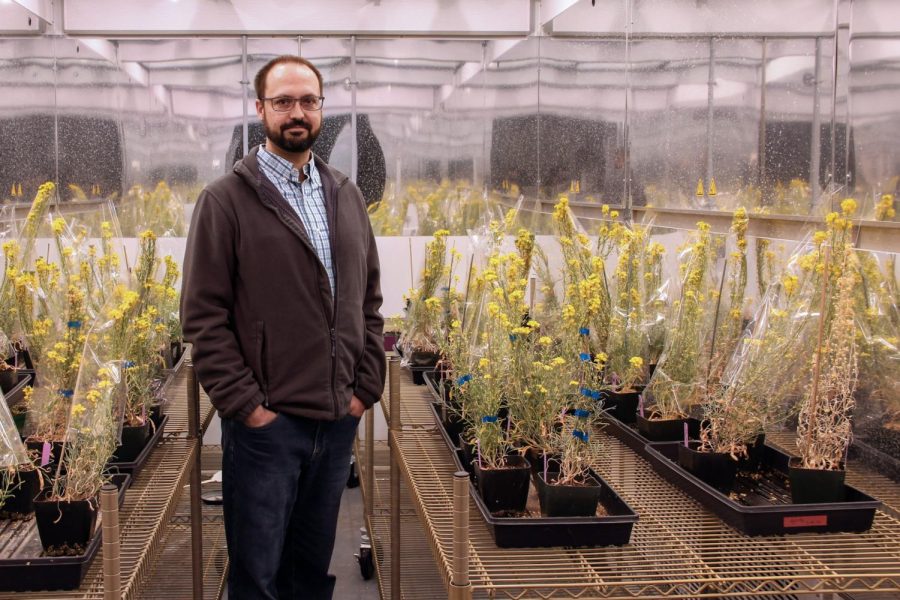Scientists engineer plants for production of biofertilizer
Scientists will engineer plants for the benefit of mycorrhizae, which helps plants take up micronutrients
Philip Bates stands in the Plant Sciences Building, Nov. 13.
December 9, 2022
A group of three international plant biologists seek to develop a system for producing fungal spores, which can be seeded with plants to act as a biofertilizer. The biofertilizer provides a more natural method of fertilizing than spraying crops.
“We’re going to engineer the plants, not for the benefit of the plant, but for the benefit of mycorrhizae,” said Mahmoud Gargouri, associate professor at the Centre of Biotechnology of Borj Cedria in Tunisia.
Arbuscular mycorrhizal fungi, or simply mycorrhizae, grows with the roots of a plant in a symbiotic, or mutually beneficial, relationship, said Philip Bates, associate professor of biological chemistry at WSU.
In this relationship, the plant makes and transfers lipids to the mycorrhizae, he said. Lipids are essential to every cell for making cell membranes and energy stores. Even the simplest bacteria make their own lipids.
Surprisingly, the mycorrhizae do not make their own lipids; they need to acquire them from the plant, he said. In return, the mycorrhizae acts as an extension of the plant’s roots, helping the plant take up micronutrients like nitrogen and metals in the soil, Bates said.
Lipids are hard to transport between organisms because they are hydrophobic and don’t pass easily through membranes, he said. To help facilitate this, mycorrhizae actually enters the cells of the host to create a fuse system.
“It seems like a very inefficient way to live,” he said.
Additionally, when plants are rototilled, or pulled from the ground for a period of time, the mycorrhizae is lost and more spores need to be seeded with the plants for the symbiotic relationship to begin again, he said.
Therefore, Bates is working in collaboration with Gargouri and Stephen Declerck, professor at the Université catholique de Louvain in Belgium, to develop a system for culturing more, stronger mycorrhizae spores.
They will be working with Medicago, a plant species commonly used for research, and genetically engineering it to produce more lipids and enhance its ability to transfer them to the mycorrhizae, Bates said.
In essence, they plan to turn the plants into factories for the mycorrhizae, Gargouri said.
“We are going to give more hamburgers to these spores, more lipids, so we can make it more fat. And if we make it more fat, it makes more spores,” he said.
Gargouri said the long-term goal is to begin mass production of the spores as a biofertilizer.
Bates said they will be using molecular techniques common in the industry. They will utilize engineered Agrobacterium, a bacteria that naturally alters plant genomes, to deliver their desired genes.
The transcription factor RAM2 increases the production of lipids essential to the mycorrhizae, according to a collaborated research paper the three scientists wrote in 2020.
Bates said this is one of the transcription factors they plan to upregulate themselves to increase the number of lipids produced.
Transcription factors are naturally occurring molecules expressed within organisms that regulate gene expression in different cells, Bates said.
“In every cell, you make different amounts of everything, right. You’re not going to make the same proteins in your eyeballs as you’re making in your toes, right?” he said.
Gargouri said he will be traveling to WSU in late December to work directly with Bates. They have been long-time collaborators. Gargouri has worked on and off with Bates since 2010.
He said his funding comes from Marie Skłodowska-Curie Actions, which allow post-doctorates to train and work on their own projects. They offered a $144,608 grant for the project.
“If you have an idea, and you want to work in your own idea, you can write a proposal and try to choose the best host wherever in the world,” he said.
Gargouri said he chose WSU because of his familiarity with the faculty and biotechnology studied there.
“I know basically all the people, what they have in expertise in technologies. And for my project I need this technology for lipidomic flux analysis, which is really mastered very well by Phil Bates,” he said.









